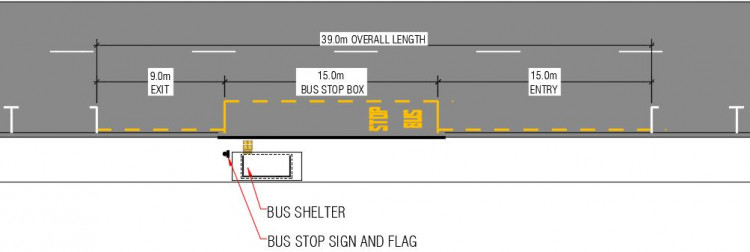Kerbside bus stops are located on the street to the side of the roadway next to the kerb edge (see the figures below). Usually, the line of the kerb does not deviate at standard kerbside bus stops.
Kerbside bus stops are the most common bus stop layout for most urban and suburban streets in New Zealand. Lead-in and lead-out space is required where the bus needs to pull out of and back into the kerbside traffic lane because of an obstruction, usually on-street parking (see the figure below). When on-street parking is too close to a kerbside bus stop, the bus may have trouble entering and exiting the stop and aligning close and parallel to the kerb.

Kerbside bus stop for a standard 13.5m bus with mounted bike rack and parking on either side. View larger image [JPG, 38 KB]
The figure below shows a linear (or ‘double’) 30m bus stop with capacity for two buses. It requires an R6-71 bus stop sign. This type of design tends to have dependent operation, that is, the first bus must pull out before the second bus can easily egress the stop. Note that bus stops longer than 30m would require a R6-71.1 bus stop sign at each end, with arrows pointing inwards.

Linear 30m bus stop with capacity for two standard 13.5m-long buses with dependent operation. View larger image [JPG, 45 KB]
The figure below shows a split stop, which has two kerbside bus stops. Consider this design when capacity warrants two or more separate stops. The consideration of a linear or split stop is based on bus stop capacity, is discussed in:

Split kerbside bus stop with parking on either side for two standard 13.5m-long buses supporting independent operation. View larger image [JPG, 49 KB]
In an urban environment, creating a length of kerb that is free from activities such as parking can be a challenge. It is made easier by using existing clear spaces such as driveways and imposing stopping restrictions near pedestrian crossings and intersections. This aids bus access while minimising the length marked out as a bus stop and has the advantage of placing stops nearer to where passengers may wish to cross the road (see the figures below)

Kerbside bus stop on the departure side of a pedestrian crossing. View larger image [JPG, 38 KB]
For more information about the design of crossing facilities, see:

Kerbside bus stop on the departure side of an intersection. View larger image [JPG, 38 KB]
Avoid vehicle crossings within the forward 9m of a bus stop box. Aim to avoid vehicle crossings within any part of the 15m length of a bus stop box, although this is sometimes unavoidable.
Never make crossings through a length of accessible kerb. When determining bus stop placement consider potential impacts on intersection sight lines, particularly for higher frequency stops. For example, as shown in the figure above a general rule of thumb is to not locate bus stops closer than 20-60m though exact distances can vary based on a variety of physical and operational factors.
PTDG: Accessibility: kerb arrangements
Street trees should be located clear of the through route and boarding spaces. Tree trunks should be at least 1m inside the face of the kerb if within the 15m length of a bus stop box. Tree canopies must be capable of being maintained clear of the bus envelope for entry, stopping and exit.
Consider tail swing when choosing the location of the bus stop and designing layout.
Underside clearance might also be problematic with excessive camber or crossfall on the road surface, and it can change over time.
Bus overhang might damage the bus and the kerb face. For more guidance on the clearance needed at bus stops, see:
PTDG: General clearance requirements
Trees and other street furniture should not obstruct sight lines between people waiting at the bus stop and the driver of an approaching bus.
When deciding the preferred bus stop layout, consider the expected behaviour of vehicles behind the bus and safety outcomes for all users. The design should achieve at least one of the following conditions:
If one of conditions is not met (that is, the width between the bus stop box and centreline is inadequate to allow for safe passing or drivers are encouraged to pass the bus on a horizontal bend, vertical crest or busy road), consider an: